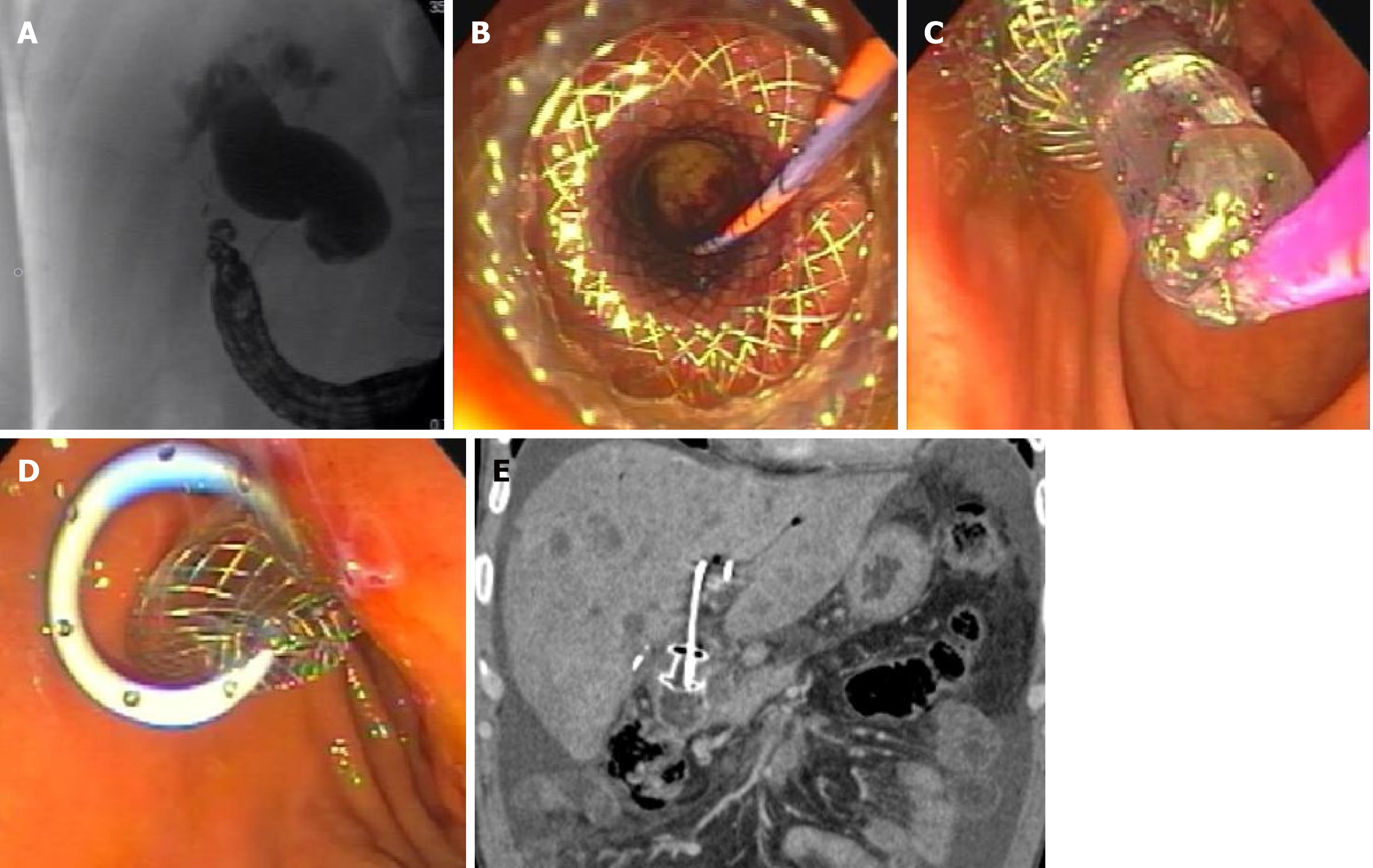Copyright
©The Author(s) 2021.
World J Gastrointest Endosc. Aug 16, 2021; 13(8): 302-318
Published online Aug 16, 2021. doi: 10.4253/wjge.v13.i8.302
Published online Aug 16, 2021. doi: 10.4253/wjge.v13.i8.302
Figure 1 Endoscopic ultrasound-guided choledochoduodenostomy for distal malignant biliary obstruction using an electrocautery-enhanced lumen apposing metal stent.
A: Fluoroscopic image showing a dilated bile duct with distal biliary stricture secondary to pancreas head mass; B: Endoscopic image following lumen-apposing self-expanding metal stent (LAMS) deployment in the common bile duct; C: Balloon dilation of LAMS using a wire-guided balloon; D: Endoscopic image with double pigtail stent through the LAMS in the duodenal bulb; E: Computed tomography coronal image showing choledochoduodenostomy with a double pigtail stent through the LAMS. The proximal end of the double pigtail plastic stent is in the left intrahepatic duct.
Figure 2 Endoscopic ultrasound-guided hepaticogastrostomy for benign distal biliary stricture in a patient with history of roux-en-Y gastric bypass surgery.
A: Endoscopic ultrasound-guided puncture of a dilated B3 radical with a 19-gauge needle; B: Fluoroscopic image showing a dilated bile duct with distal biliary stricture; C: Fluoroscopic image showing placement of a fully covered hepaticogastrostomy metal stent; D: Antegrade balloon dilation of the distal bile duct stricture using a wire-guided balloon; E: Successful placement of four 7 Fr × 18 cm double pigtail biliary stents with the distal end past the ampulla in the small bowel and the proximal end in the stomach; F: Occlusion cholangiogram following removal of plastic hepaticogastrostomy stents showing resolution of distal bile duct stricture with free flow of contrast into the small bowel.
Figure 3 Endoscopic ultrasound-guided gallbladder drainage for distal malignant biliary obstruction secondary to duodenal adenocar
Figure 4 Endoscopic ultrasound-directed transgastric endoscopic retrograde cholangiography for choledocholithiasis in a patient with history of roux-en-Y gastric bypass surgery.
A: Endoscopic ultrasound-guided puncture of excluded stomach using a 19-gauge needle; B: Endoscopic ultrasound showing deployment of proximal flange of lumen-apposing self-expanding metal stent (LAMS) in the excluded stomach; C: Endoscopic image showing distal flange of LAMS in the gastric pouch; D: Fluoroscopic image of endoscopic retrograde cholangiopancreatography through LAMS showing multiple stones in the common bile duct; E: Gastrogastric fistula seen following LAMS removal; F: Successful closure of gastrogastric fistula using argon plasma coagulation and clips.
Figure 5 Proposed algorithm for endoscopic ultrasound-guided biliary drainage for biliary obstruction following failed endoscopic retrograde cholangiopancreatography.
EUS: Endoscopic ultrasound; HGS: Hepaticogastrostomy; CDS: Choledochoduodenostomy; ERCP: Endoscopic retrograde cholangiopancreatography; EDGE: EUS-directed transgastric ERCP; GBD: Gallbladder drainage; RV: Rendezvous.
- Citation: Pawa R, Pleasant T, Tom C, Pawa S. Endoscopic ultrasound-guided biliary drainage: Are we there yet? World J Gastrointest Endosc 2021; 13(8): 302-318
- URL: https://www.wjgnet.com/1948-5190/full/v13/i8/302.htm
- DOI: https://dx.doi.org/10.4253/wjge.v13.i8.302













